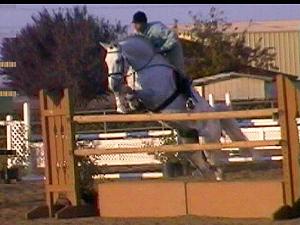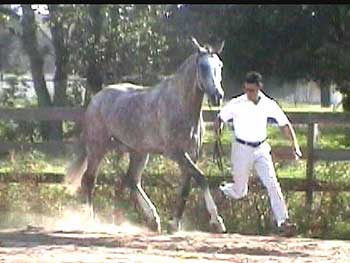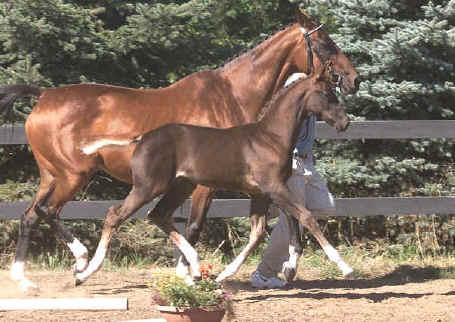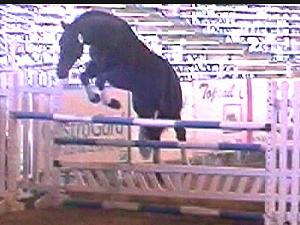Warmbloods
by Rebecca Pennington
(originally published May 19, 2002)
by Rebecca Pennington
(originally published May 19, 2002)
This is a tough one, because the term has begun to be loosely tossed around in North America. I can tell you for sure that a warmblood is NOT a cross between a hot blood and a cold blood. Don’t let anyone tell you different. There are only two types of “hot-blooded” horses in the world. These are the Thoroughbred and the Arabian. Draft horses are considered “cold-blooded.” Many people in the United States have been lead to believe that if you cross any hot-blooded horse and any cold-blooded horse, you get a “warmblood.” Sounds simple, huh? NOT! What you have in such a mating is a “draft-cross.” Likewise, breeding a Thoroughbred and a Quarter Horse (as an example) does not give you a warmblood.
 A good definition of a “warmblood” might be: “A Warmblood is a horse with at least 5 generations of recognized sport horse bloodlines and that has been inspected and registered by world-recognized breeding associations to excel in the sports of dressage and/or show jumping. “ You see, the Europeans have for many generations been breeding horses that are very specialized to excel in show jumping and/or dressage. In order to make sure that the horses were of the best quality for these sports, both mares and stallions had to be presented for inspection and had to be approved for breeding in order for a foal to be given registration papers. In this way, only those horses exhibiting the best qualities were allowed to pass on their genes. It is true that in the far away beginnings and to develop these horses, some draft blood was initially used. And even today, some Thoroughbred and Arabian blood is sometimes used to lighten the horses. But these Thoroughbred and Arabian horses must first pass rigid inspection and be approved for use in the registry’s bloodlines.
A good definition of a “warmblood” might be: “A Warmblood is a horse with at least 5 generations of recognized sport horse bloodlines and that has been inspected and registered by world-recognized breeding associations to excel in the sports of dressage and/or show jumping. “ You see, the Europeans have for many generations been breeding horses that are very specialized to excel in show jumping and/or dressage. In order to make sure that the horses were of the best quality for these sports, both mares and stallions had to be presented for inspection and had to be approved for breeding in order for a foal to be given registration papers. In this way, only those horses exhibiting the best qualities were allowed to pass on their genes. It is true that in the far away beginnings and to develop these horses, some draft blood was initially used. And even today, some Thoroughbred and Arabian blood is sometimes used to lighten the horses. But these Thoroughbred and Arabian horses must first pass rigid inspection and be approved for use in the registry’s bloodlines.
The actual registries for these horses was, at first, regional in nature, since when this breeding began people had to use local stallions for the most part. Horses bred in Hannover, Germany, were registered as “Hannoverians.” Horses bred in Oldenburg were registered as “Oldenburgers.” Occasionally, a stallion was sold from one region to another and, thus, a stallion registered in Hannover, Germany, as a “Hannoverian” might get sold to Holstein, Germany, and begin siring horses that were registered as “Holsteiners.” This regional limitation in the bloodlines and the fact that each region had its own breeding goals and were breeding for certain qualities, resulted in there being an almost distinct type of horse within each registry. For example, the Hannoverian horses tended to be excellent, heavy-boned dressage types; the Holsteiners began to be lighter horses that excelled in show jumping.
 As the world got smaller with the advent of better transportation and artificial breeding techniques, the bloodlines began to mix somewhat. Horses were bought and sold outside their region – even world-wide. America discovered them! Since the U.S. did not have such a breed of specialized horse of its own and the idea of inspections and approval before breeding was unheard of (!) here, the European registries were asked to “affiliate” with newly-forming North American registries that wished to follow the European criteria of inspection and approval and to use the same bloodlines. Instead of forming an “American Warmblood Registry” [yes, there is one – two, in fact – and I’ll get to that in a moment], the North Americans wanted to form North American counter-parts for the Hannoverian, Holsteiner, Oldenburg, Dutch, etc. registries, and to use the inspection criteria from Europe for each. Thus was born the American Hanoverian Society, the Oldenburg North America, the American Holsteiner Horse Association, etc.
As the world got smaller with the advent of better transportation and artificial breeding techniques, the bloodlines began to mix somewhat. Horses were bought and sold outside their region – even world-wide. America discovered them! Since the U.S. did not have such a breed of specialized horse of its own and the idea of inspections and approval before breeding was unheard of (!) here, the European registries were asked to “affiliate” with newly-forming North American registries that wished to follow the European criteria of inspection and approval and to use the same bloodlines. Instead of forming an “American Warmblood Registry” [yes, there is one – two, in fact – and I’ll get to that in a moment], the North Americans wanted to form North American counter-parts for the Hannoverian, Holsteiner, Oldenburg, Dutch, etc. registries, and to use the inspection criteria from Europe for each. Thus was born the American Hanoverian Society, the Oldenburg North America, the American Holsteiner Horse Association, etc.
In the beginning, the horses were imported from Europe. Then the Americans began breeding their own. Because most of the European registries allowed Thoroughbreds and Arabians (after strict inspection) to be used as breeding stock, and America had lots more of these horses than registered warmbloods, the Americans based much of their breeding program on these mares (especially Thoroughbred) and bred them to approved Warmblood stallions. The resulting foals were registered with the North American warmblood registry that had approved the mare (and with which the stallion was approved – more on that later). More and more European-bred warmbloods have been imported into North America and the Americans have begun breeding warmblood horses that are every bit as good as those found in Europe. If you own a horse born and branded in America as “Hanoverian,” “Oldenburg,” “Dutch,” “Holsteiner,” etc., you can be assured that you are getting a top quality horse that has been bred based on the stringent criteria of the Europeans.
Having said all this, what about the “American Warmblood?” Another touchy subject. I am an American and I’d LOVE to be able to say that my horses (because they were born and bred in America of approved sport horse bloodlines and based on strict inspection criteria to excel in dressage and/or show jumping) are “American Warmbloods.” It would make me proud. However, the term “American Warmblood” has, unfortunately, come to be associated with the before-mentioned “draft cross,” making the term a derogatory one to many. Until that term loses its association with a draft cross or a “mutt” horse from bloodlines/horses that have not had at least 5 generation of approved/inspected parentage, I will not use it in association with my horses.
First, you must recognize that each registry has its own criteria on which to base its gradings. The only thing in common between the warmblood registries is that registration is a separate thing from approval for breeding. Most inspect the offspring before they give them registration papers. Usually this is just perfunctory, as the mare and stallion have previously both been approved by that registry, so the resulting offspring is entitled to registration. More on this later.
Before a foal can be registered with any of the European-based warmblood registries, BOTH parents must have been presented to that registry for inspection and have received sufficient scores to “approve” them for breeding. The criteria on which this approval is based differs with each registry somewhat, as each registry is looking for horses that meet their general goals. A mare or stallion might meet the requirements of one registry and be approved, but might not meet the specific requirements of another registry and fail to be approved. This does NOT mean that one registry has stricter requirements than another. They just look for different “types.”
A mare or stallion might meet the requirements of one registry and be approved, but might not meet the specific requirements of another registry and fail to be approved. This does NOT mean that one registry has stricter requirements than another. They just look for different “types.”
When a mare is presented to a registry for approval, she will receive scores in various categories including parts of her body, movement, type, etc, all according to that registry’s criteria. The score she receives will determine in which of the “mare books” or “stud books” for that registry she is placed. Mare book and Stud book are the same; some registries call it one, others call it the other. Usually there are 4 categories of mare/stud book — Pre-Stud/Mare (the lowest and used for low scoring mares or mares whose pedigree for whatever reason is not sufficient to allow them entry into a higher book no matter how well they score), Stud/Mare book (used for mares whose scores are in a certain range or meet minimum requirements for pedigree), Main Stud/Mare for high scoring mares, and the top books which vary depending upon registry. In the Oldenburg registry it is called “Premium Mare Book,” The Hanoverian registry calls it “Elite Mare,” and the Dutch call it “Star Mare”. For some registries, mares cannot just score into this top book. Instead, they must meet other stringent criteria. For example, to become an Elite Mare, the Hanoverian registry requires the mare (among other requirements) to have been born of a mare that was at least in the Main mare book, to have scored high enough to get into the Main mare book herself, to pass a Mare performance test and to produce a good quality foal. Some registries allow a mare to “move up” one book if she takes and passes a “Mare Performance Test.”
 Because a stallion can have a much larger impact on a breed than a mare (by virtue of being able to breed so many mares), warmblood stallions must usually undergo a grueling 100 days of testing (since this article was first written, this requirement has changed to a 30 day and then a 70 day test period) or have received many wins at the highest levels of dressage or show jumping (as well as passing inspection scores for conformation and temperament) in order to be approved for breeding. Only the best will make it.
Because a stallion can have a much larger impact on a breed than a mare (by virtue of being able to breed so many mares), warmblood stallions must usually undergo a grueling 100 days of testing (since this article was first written, this requirement has changed to a 30 day and then a 70 day test period) or have received many wins at the highest levels of dressage or show jumping (as well as passing inspection scores for conformation and temperament) in order to be approved for breeding. Only the best will make it.
Horses can be registered with only one registry. However, mares and stallions can be presented to and approved for breeding by more than one registry as long as they meet the requirements of that registry. It is for that reason that you could have a Hanoverian stallion that is approved by the Hanoverian, Oldenburg and RPSI. If you mate him to a Westfalien mare that is approved Westfalen, Oldenburg and RPSI, the resulting foal could be registered as either Oldenburg or RPSI (since the only requirement for registration is APPROVAL of both parents by a registry). So, the foal of a Hanoverian stallion and a Westfalen mare could be registered Oldenburg! Get it?
At the foal inspections, a few of the registries (most notably ISR/Oldenburg NA and the RPSI) give scores to the foal and will award a high scoring foal the designation of “premium foal.” This title and score mean only that the foal looked and moved wonderfully that day and while it is an indication of a top quality horse-to-be, the failure of a foal to receive a “premium” at its inspection CANNOT be used as an indication that the foal is LESS than stellar. It is only one day in the life of that foal. If the inspectors had seen him/her a day before or a day later, the foal might have received a premium rating.
I hope this helps. And I apologize to those who will see my explanation as an oversimplification and be upset by my not going into greater detail in the inspection requirements. I did not think it necessary for this “warmbloods 101” short course. For more information, click below to go to the web sites of the individual registries.